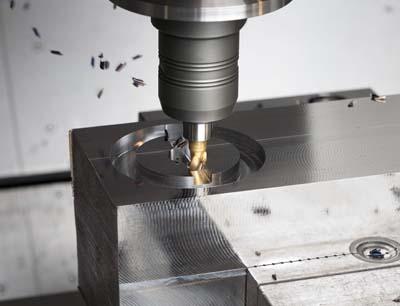
Seco Tools introduced its original Minimaster line of end mills with replaceable carbide inserts nearly 25 years ago. Today, the company is presenting its new Minimaster Plus, with advanced features for tackling the most demanding of milling applications in steel, stainless steel, cast iron, aluminum and other difficult-to-machine materials.
The most notable new feature on the Minimaster Plus is the high-precision interface between the replaceable carbide insert and the steel shank. The insert has an internal thread and external taper, while the shank has an internal taper with a threaded center pin for added reliability and stability as well as minimized run-out.
Additionally, a new axial stop on the shank increases repeatability and productivity by allowing end users to replace an insert without having to remove the tool from machine spindles. The new insert then repositions axially within 25µm.
Intended for general machining in the aerospace, power generation, die and mold, automotive and medical industries, the highly productive Minimaster Plus replaceable tip milling system makes tool-length re-measurement obsolete. The milling system offers a large selection of inserts and shanks for a multitude of tough milling applications.
Twenty-four versions of the shank are available, along with square shoulder and ball nose inserts that have through-tool coolant on all two and three flute designs for excellent cooling and efficient chip removal.
Inserts come in two grades for machining all types of materials and E- and Mgeometries for a smooth cutting design. Insert diameters range from 0.375" to 0.625", and corner radii are available from 0.0157" to 0.122" to match a variety of design requirements.
Contact Details
Related Glossary Terms
- coolant
coolant
Fluid that reduces temperature buildup at the tool/workpiece interface during machining. Normally takes the form of a liquid such as soluble or chemical mixtures (semisynthetic, synthetic) but can be pressurized air or other gas. Because of water’s ability to absorb great quantities of heat, it is widely used as a coolant and vehicle for various cutting compounds, with the water-to-compound ratio varying with the machining task. See cutting fluid; semisynthetic cutting fluid; soluble-oil cutting fluid; synthetic cutting fluid.
- gang cutting ( milling)
gang cutting ( milling)
Machining with several cutters mounted on a single arbor, generally for simultaneous cutting.
- milling
milling
Machining operation in which metal or other material is removed by applying power to a rotating cutter. In vertical milling, the cutting tool is mounted vertically on the spindle. In horizontal milling, the cutting tool is mounted horizontally, either directly on the spindle or on an arbor. Horizontal milling is further broken down into conventional milling, where the cutter rotates opposite the direction of feed, or “up” into the workpiece; and climb milling, where the cutter rotates in the direction of feed, or “down” into the workpiece. Milling operations include plane or surface milling, endmilling, facemilling, angle milling, form milling and profiling.
- shank
shank
Main body of a tool; the portion of a drill or similar end-held tool that fits into a collet, chuck or similar mounting device.

